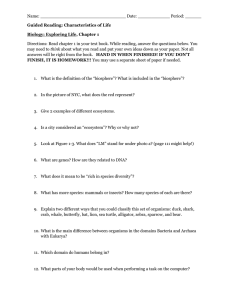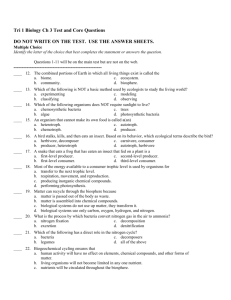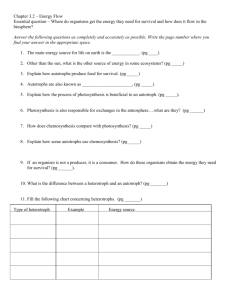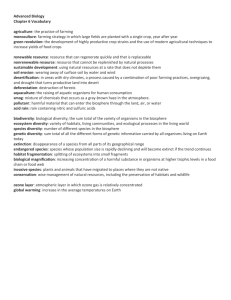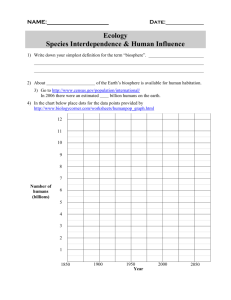d. ecology
advertisement
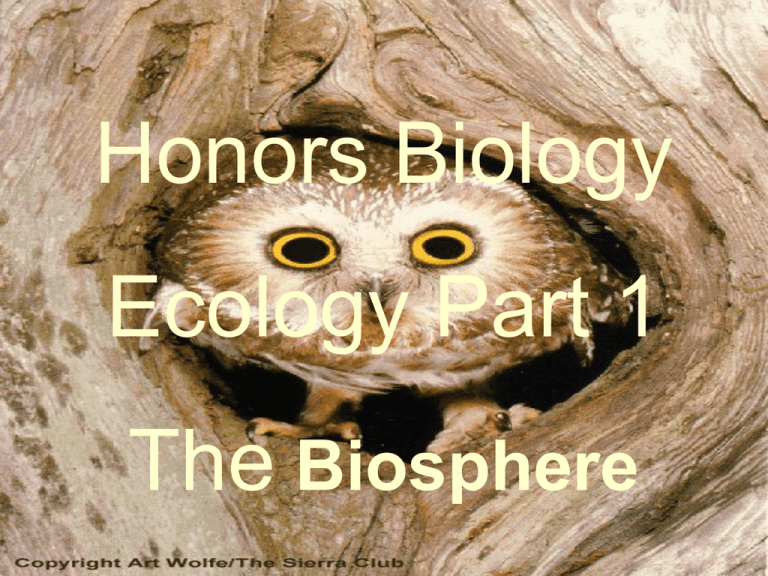
Honors Biology Ecology Part 1 The Biosphere I. The Biosphere A. What is Ecology? 1. Ecology (from Greek oikos, meaning “house”) 2. Aspects of Ecological study a. Biosphere- portion of the Earth that supports life 1). Extends 8 kilometers above Earth’s surface, to as far as 11 kilometers below the surface of the Earth 2). Living things affected by both physical environment and by other living things a). Abiotic factors- nonliving parts of an organisms environment (air currents, temperature, light, soil, etc.) b). Biotic factors- all living organisms that inhabit an environment B. Levels of Organization- ecologists study interactions among organisms at several different levels 1. Species- group of organisms so similar to one another that they can breed and produce fertile offspring 2. Populations- group of individuals that belong to same species and live in the same area 3. Communities- group of different populations that live together in a defined area. 4. Ecosystem- collection of all the organisms that live in a particular place, together with nonliving, or physical, environment. 5. Biomes- geographical region containing several ecosystems that have same climate and dominant communities (climax communities) 6. Biosphere- portion of the planet where life exists. II. Energy Flow- (core or every organism’s interaction with the environment is its need for energy to power life’s processes. A. How Organisms obtain energy 1. Producers- make their own food. Autotrophs- use energy from environment to manufacture their own nutrients. Two main types of producers a. Energy from the sun- use solar energy in process known as photosynthesis- use light energy to convert carbon dioxide and water into oxygen and energy-rich carbohydrates 1). Plants main autotrophs on land 2). Algae main autotrophs in freshwater ecosystems and photic zone of ocean b. Life without light- chemosynthesis- use chemical energy to produce carbohydrates 1). Performed by several types of bacteria 2). Live in remote places: volcanic vents, deepocean vents, hot springs 2. Consumers- acquire energy from other. Heterotrophs- organisms that rely on other organisms for their energy and food supply. Many different types a. Herbivores- obtain energy by eating only plants b. Carnivores- eat animals (snakes, dogs, owls, etc.) c. Omnivores- eat both plants and animals (e.g. humans) d. Decomposers- breaks down organic matter (bacteria and fungi) 3. Feeding Relationships a. Energy flows through ecosystem in one direction (from sun or inorganic compounds to autotrophs to heterotrophs) 1). Food chains- series of steps in which organisms transfer energy by eating and being eaten 2). Food Web- network of complex interactions that links all the food chains in an ecosystem together a). Trophic levelseach step in food chain or web b). Producers make up first level, then consurmers 4. Ecological pyramids- used to represent amount of energy or matter in each trophic level in a food chain or web. (three types) a. Energy pyramidrepresents amount of energy that is passed onto each trophic level (only about 10% is available to succeeding levels. Remainder lost as heat into the environment. b. Biomass pyramid- represents the total amount of living tissue within a given trophic level. (biomassgrams of organic matter per unit area) c. Pyramid of numbers- represents number of individual organisms at each trophic level. Shape of pyramid not always the same as energy of biomass pyramid III. Cycles of Matter- unlike energy, matter is recycled within and between ecosystems A. Biogeochemical cyclesprocess by which elements, chemical compounds, and other forms of matter are passed (cycled) from one organisms to another and from one part of the biosphere to another. (cycles connect biological, geological, and chemical portions of biosphere) 1. The Water Cycle a. evaporation- process by which liquid water changes to atmospheric gas b. transpiration- water evaporating from leaves of plants 2. Nutrient cycles- cycling of nutrients (minerals and other chemicals) that sustain life. a. Nutrients are frequently in short supply b. Nutrient cycling keeps many chemicals from reaching toxic concentrations c. Three main nutrient cycles 1). Carbon cycle- key ingredient in all living things. (4 processes involved) a). Biological processes- photosynthesis, respiration, decomposition. b). Geochemical processes- release CO2 by volcanoes c). Mixed biogeochemical- burial of carbon-rich remains and conversions into coal and fossil fuels by pressure of overlying earth d). Human activity- mining, burning of fossil fuels, cutting down/burning forests 2). Nitrogen cycle- need nitrogen to make amino acids which are used to make proteins a). 78% atmosphere is nitrogen (can only be utilized by certain bacteria in process called nitrogen fixation) b). Nitrogen-containing substances found in wastes produced by many organisms and in dead and decaying organic matter. c). Shows how different forms of nitrogen cycle through the biosphere. d). Denitrification- conversion of ammonia and other nitrogen-containing nutrients into nitrogen gas 3). Phosphorus cycle- essential because forms part of ATP molecule needed by all living things a). Not very common in biosphere. Exists mostly in rock, minerals, ocean sediment. b). Inorganic phosphate absorbed by plants and turned into organic compounds which can be utilized. B. Nutrient limitation- it nutrient in short supply, it will limit an organism’s growth 1. Limiting nutrient- when ecosystem is limited by single nutrient that is scarce or cycles very slowly a. Farmers use fertilizers to boost plant productivity b. Bloom- when aquatic ecosystems receive large input of limiting nutrient can cause rapid growth of producers Extensive bloom of green algae covers the shoreline of Tule Lake in California Red-tide (Florida) Review Chapter 3 The Biosphere The branch of biology dealing with interactions among organisms and between organisms and their environment is called a. economy. b. modeling. c. recycling. d. ecology. The branch of biology dealing with interactions among organisms and between organisms and their environment is called a. economy. b. modeling. c. recycling. d. ecology. The part of Earth in which all living things exist is called the a. biome. b. community. c. ecosystem. d. biosphere. The part of Earth in which all living things exist is called the a. biome. b. community. c. ecosystem. d. biosphere. All of the members of a particular species that live in one area are called a(an) a. biome. b. population. c. community. d. ecosystem. All of the members of a particular species that live in one area are called a(an) a. biome. b. population. c. community. d. ecosystem. Green plants are a. producers. b. consumers. c. herbivores. d. omnivores. Green plants are a. producers. b. consumers. c. herbivores. d. omnivores. What is the original source of almost all the energy in most ecosystems? a. carbohydrates b. sunlight c. water d. carbon What is the original source of almost all the energy in most ecosystems? a. carbohydrates b. sunlight c. water d. carbon The algae at the beginning of the food chain in Figure 3-1 are a. consumers. b. decomposers. c. producers. d. heterotrophs. The algae at the beginning of the food chain in Figure 3-1 are a. consumers. b. decomposers. c. producers. d. heterotrophs. An organism that produces its own food supply from inorganic compounds is called a(an) a. heterotroph. b. consumer. c. detritivore. d. autotroph. An organism that produces its own food supply from inorganic compounds is called a(an) a. heterotroph. b. consumer. c. detritivore. d. autotroph. Which of the following organisms does NOT require sunlight to live? a. chemosynthetic bacteria b. algae c. trees d. photosynthetic bacteria Which of the following organisms does NOT require sunlight to live? a. chemosynthetic bacteria b. algae c. trees d. photosynthetic bacteria An organism that cannot make its own food is called a(an) a. heterotroph. b. chemotroph. c. autotroph. d. producer. An organism that cannot make its own food is called a(an) a. heterotroph. b. chemotroph. c. autotroph. d. producer. In which way are green plants in a sunny mountain meadow and sulfur bacteria in a deep-sea volcanic vent alike? a. They both use photosynthesis to make their own food. b. They both produce carbohydrates and oxygen c. They both use chemosynthesis to produce their own food. d. They both produce carbon and hydrogen. In which way are green plants in a sunny mountain meadow and sulfur bacteria in a deep-sea volcanic vent alike? a. They both use photosynthesis to make their own food. b. They both produce carbohydrates and oxygen c. They both use chemosynthesis to produce their own food. d. They both produce carbon and hydrogen. Organisms that break down and feed on wastes and dead organisms are called a. decomposers. b. omnivores. c. autotrophs. d. producers. Organisms that break down and feed on wastes and dead organisms are called a. decomposers. b. omnivores. c. autotrophs. d. producers. What is an organism that feeds only on plants called? a. carnivore b. herbivore c. omnivore d. detritivore
